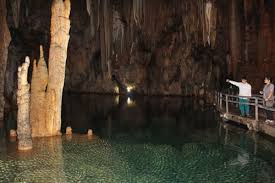
(HBO) - We visited Nam Son cave, Nam Son commune (Tan Lac) on the last days of July. We were quite surprised when we moved through a cave of about 1m high and we saw a wide open space in the cave. There are blocks of virtual fossils. The air in the cave is cool and the holy sound of water is like a light wordless song.
More than ten years ago, some local people accidentally lost
their way into the heart of the cave and the saw a really beauty there. Since
then, many people have come there to explore. Nam Son cave is also called Ton
cave by the local people. The cave is located at an altitude of nearly 1,000
meters above the sea level. It has a length of 455m, a depth of 49m with a
large lake surface, from 2 to 7m deep, and the water is transparent throughout
the year. In addition to owning a treasure of stone columns, stalactites,
stalagmites and stone curtains, it has also preserved many artifacts relating
to history, culture and beliefs and is habitat of many bats, the animals and
the endemic creatures.
The scientists have recognized Nam Son as the most beautiful
and attractive cave in the population of caves discovered in Ngoc Son - Ngo
Luong Nature Reserve with the blocks of stone developed over the course of
about 250 million years. Nam Son Cave
was recognized as a national landscape relic in 2008.
Currently, the authorities of Nam Son commune have conducted
the propaganda to raise the awareness of protecting the landscape of tourism
resources. The province and district have also planned and invested in some
items such as steps up and down, the lighting system, training to guide
tourists to visit the cave area.
On July 25th, Tan Lac district organized the
opening ceremony of the community tourism spot in the Nam Son commune.
Accordingly, they will implement the propaganda solution and they will train
the skills to make tourism to exploit the tourism potential of Nam Son in
association with preserving the unique cultural values of Muong ethnic people.
Besides connecting the tours, the routes, building the private tourism products
of the highlands such as Nam Son ancient tangerine, the purple garlic, chayote
and other products from the local people. Since then, developing tourism will
contribute to the sustainable poverty reduction.
Located just a 20-minute drive from Hoa Binh City, Ora Hill Farmstay & Glamping Hoa Binh is a captivating new destination nestled in Mo hamlet, Bình Thanh commune, Cao Phong district. Combining farming with leisure, this tranquil retreat is perfect for those seeking balance, joy, and an immersive experience in the expansive beauty of nature.
Muong Bi - Tan Lac is renowned as one of the four famous Muong regions in Hoa Binh province. Blessed by nature with a favourable climate and stunning landscapes, Tan Lac holds great advantages for tourism development. The local tourism industry has made remarkable strides in recent times thanks to the attention and support from the local authorities and sectors.
With its strategic location, well-developed transport network, and diverse soil and climatic conditions, Hoa Binh is emerging as a must-visit destination in Vietnam's northwestern tourism corridor. The province boasts numerous attractions, including the Kim Boi hot springs (Kim Boi district), the Dau Rong cave complex (Cao Phong), the Mai Chau valley (Mai Chau), and the iconic Hoa Binh hydropower plant.
The northern mountainous province of Hoa Binh has been listed among the 71 most beautiful places to visit worldwide by the prestigious US travel magazine Condé Nast Traveller.
Hoa Binh province’s rich natural and cultural resources position it as a prime location for developing community-based tourism (CBT). In recent years, support from central and provincial policies, as well as assistance from non-governmental organisations, have encouraged local ethnic minority and mountainous communities to actively engage in the sector.


